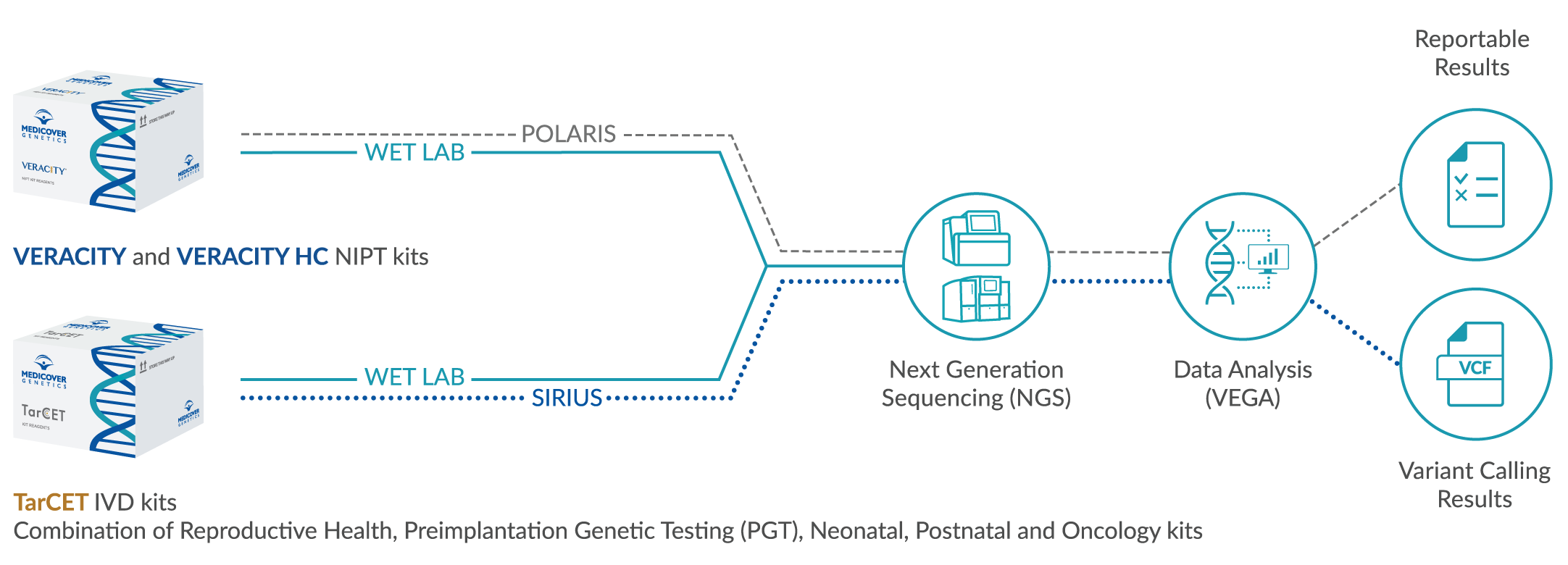Contents
Genetic causes of infertility
According to the World Health Organization (WHO), ‘infertility is a disease of the reproductive system, defined by the failure to achieve a clinical pregnancy after 12 months or more of regular, unprotected sexual intercourse’ [1]. Worldwide, the number of people affected by infertility is over 48.5 million people [2]. 1 in 8 couples in the US and 1 in 7 couples in the UK face infertility [3, 4]. In developing countries, infertility rate is even higher, with 1 in 4 couples being affected [5].
A couple with a normal functioning reproductive system has a 20-25% chance of conceiving at any given month [6]. After 6 months of trying, 60% of those couples will conceive without medical assistance [6].
Infertility affects both men and women equally. Approximately 30% of infertility is due to female factors and 30% due to male factors. The remaining cases are due to problems in both partners, or have an unexplained etiology [7]. The most important contributing factor for infertility is maternal age. Paternal age plays a role, but not as central. As women are born with all their eggs, their quantity and quality decreases overtime. Consequently, it is harder for women who are older to conceive and carry a pregnancy to term. In general, guidelines recommend seeing a fertility specialist after 12 months of unsuccessful trying; however, women over the age of 35 are advised to consult a specialist after 6 months – and not wait for a year.
Causes of infertility
Causes of infertility can vary, and a personal, thorough clinical examination and family history must be taken by a specialist. Infertility can have genetic, hormonal or structural causes, and the cause may also be unknown or unexplained.
Genetic causes of infertility
Genetic causes include translocations (incorrect rearrangement of chromosomes) and other structural or numerical chromosome changes in one of the partners.
Genetic causes of infertility in women
Both polycystic ovarian syndrome and endometriosis are multifactorial disorders with a probable genetic component, and both are causes of infertility in women [8]. Some other genetic causes of female infertility are listed below [9].
- Premature ovarian failure
- Leiomyoma
- Turner syndrome (monosomy X)
- Noonan syndrome
- Sickle cell disease
- Galactosemia
- Fragile X-associated primary ovarian insufficiency
- Kallman syndrome
- Congenital adrenal hyperplasia
Genetic causes of infertility in men
Klinefelter syndrome, caused by the presence of an extra X chromosome, is the most common cause of male infertility. Some other genetic causes of male infertility are listed below [9].
- Azoospermia
- Oligozoospermia
- 47,XYY (double Y syndrome)
- Y chromosome microdeletions
- Testicular disorder of sex development (46,XX)
- Testicular dysgenesis disorders
- Kallman syndrome
- Congenital bilateral aplasia of the vas deferens
- Androgen insensitivity syndrome
- Sickle cell disease
- Kartagener Syndrome
- Myotonic dystrophy
- Fanconi anemia
- β-thalassemia
- Cystic fibrosis
Other causes of infertility
Hormonal levels, caused by ovulatory disorders, poor response to fertility treatments, premature ovarian failure or polycystic ovarian syndrome and health conditions including endometriosis can also cause infertility.
Structural problems of the uterus, cervical factors or issues with the sperm production or transportation to the egg, immune disorders, and environmental factors can all affect fertility. Infertility can also occur after having a baby without difficulty, and sometimes, infertility is unexplained.
The personal side of infertility
Couples or people who know they might be affected by infertility, if they have experienced multiple miscarriages or have known risk factors for infertility, like endometriosis, may also consult their doctor and seek an expert’s opinion as early as they wish. Couples have a right to advocate for themselves, seek treatment, explore their options – fertility treatments, surrogacy, and adoption – and take their own decisions for their families, even if these decisions are taking no actions at all.
The perceived stigma surrounding infertility often prevents people from talking about, or admitting, their fertility challenges. The desire to have children and the inability to accept infertility as a disease of the reproductive system does not only feel like a biological fail, but a personal one. Infertility is unlike other medical conditions with defined pathways and mechanisms of action. Treatment might need to be emotional as well as physical, and above all, personal. As friends, family or society, all we can do is to provide emotional support, promote discussion and understanding in a way that enables better policies and more affordable and accessible fertility treatments on this global public health issue.
Advocacy
The US National Infertility Awareness Week (NIAW), founded in 1989 by Resolve, recently celebrated 30 years. Resolve’s aims are to enhance public understanding on infertility, ensure couples wishing to start a family know the guidelines, and educate lawmakers on the impact of infertility policies. These empower Resolve’s purpose, which is to eliminate the barriers and the stigmas that stand in the way of building families.
For more information on support groups, please visit: https://fertilitynetworkuk.org/access-support/, https://infertilityawareness.org/, or https://resolve.org/.
Find out more about the role of genetics in reproductive health here and azoospermia in our article, Understanding azoospermia, one of the most common causes of male infertility, here.
References
[1] Zegers-Hochschild F. et al. (2009) International Committee for Monitoring Assisted Reproductive Technology (ICMART) and the World Health Organization (WHO) revised glossary of ART terminology, 2009 https://www.fertstert.org/article/S0015-0282(09)03688-7/fulltext
[2] Mascarenhas M. et al. (2012) ‘National, regional and global trends in Infertility prevalence since 1990: A systematic analysis of 277 health surveys’. PLoS Medicine; 9:e1001356. https://journals.plos.org/plosmedicine/article?id=10.1371/journal.pmed.1001356
[3] 2006-2010 National Survey of Family Growth, CDC (2017) https://www.cdc.gov/nchs/nsfg/key_statistics/i.htm#infertility
[4] National Institute for Health and Clinical Excellence, Manchester (2013) Fertility: Assessment and Treatment for People with Fertility Problems. NICE Clinical Guideline. https://www.nice.org.uk/guidance/cg156
[5] World Health Organization, Sexual and Reproductive Health (2019) https://www.who.int/reproductivehealth/topics/infertility/burden/en/
[6] Resolve (2019) https://resolve.org/infertility-101/what-is-infertility/fast-facts/
[7] American Society for Reproductive Medicine, Reproductive Facts, (2019) https://www.reproductivefacts.org/faqs/frequently-asked-questions-about-infertility/
[8] How Much of Infertility Is Genetic? Healthline. Retrieved 25 May 2023 from https://www.healthline.com/health/womens-health/is-infertility-genetic#in-females
[9] Zorrilla M, Yatsenko AN. The Genetics of Infertility: Current Status of the Field. Curr Genet Med Rep. 2013 1(4):10.1007/s40142-013-0027-1. doi: 10.1007/s40142-013-0027-1. PMID: 24416713; PMCID: PMC3885174. https://www.ncbi.nlm.nih.gov/pmc/articles/PMC3885174














